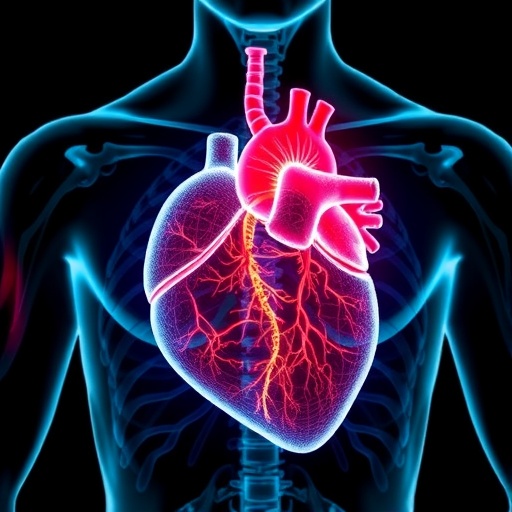In a groundbreaking study, researchers have unveiled critical insights into the role of PRMT5, a protein associated with gene regulation, in the context of cardiac hypertrophy and heart failure. The study revolves around the cardiac-specific overexpression of PRMT5 and its malignant implications as an exacerbation of pressure overload-induced hypertrophy, a condition often leading to heart failure. This research not only highlights the biological mechanisms at play but also sparks significant interest for potential therapeutic pathways in cardiac diseases.
Cardiac hypertrophy is a pathological condition characterized by the thickening of the heart muscle, which often precedes heart failure. The progression from hypertrophy to heart failure has garnered extensive research focus due to the alarming rates at which heart failure cases have risen globally. In their research, Katanasaka and colleagues meticulously examined how elevated levels of PRMT5, a member of a family of enzymes that add methyl groups to arginine residues in proteins, can significantly influence cardiac cell growth and function under stress conditions.
PRMT5’s role in cellular signaling pathways has been well established, but its cardiac implications remain insufficiently characterized prior to this study. By employing advanced genetic engineering techniques, the research team generated a mouse model with cardiac-specific overexpression of PRMT5. Through this ingenious approach, they were able to simulate the pathological conditions of human heart diseases, providing an invaluable platform for observing physiological changes in real-time.
During stress tests mimicking pressure overload—such as the application of aortic constriction—researchers noted a marked increase in myocardial wall thickness in the genetically modified mice. This finding supports the hypothesis that PRMT5 directly influences hypertrophic signaling pathways. The transition from normal to hypertrophied cardiac cells can lead to various adverse outcomes, including reduced pumping efficiency and, ultimately, cardiac failure.
Interestingly, the team also discovered that the overexpression of PRMT5 correlated with heightened levels of specific markers typically associated with the stress response in cardiac cells. This included notable increases in hypertrophic markers like ANP (A-type natriuretic peptide) and BNP (B-type natriuretic peptide), which are often utilized clinically to assess heart failure. The implications of these findings suggest that PRMT5 could serve as a valuable biomarker for the early detection of cardiac hypertrophy.
Delving deeper into molecular pathways, the researchers identified that PRMT5 overexpression leads to dysregulation in signaling pathways such as the Akt and ERK pathways that are crucial for maintaining cardiac cell function and growth. Disruptions in these pathways can pave the way to pathological hypertrophy and heart failure, reinforcing the role of PRMT5 as a crucial regulatory protein in heart health. This revelation intensifies the appeal of PRMT5 as a potential target for therapeutic intervention in heart disease management.
The methodology used in this study was particularly noteworthy. The application of genetic mouse models permitted researchers to explore the effects of PRMT5 in a controlled environment, addressing variables that might cloud results in human population studies. Furthermore, by integrating echocardiography and histological studies, the team could validate their hypothesis concerning structural changes in cardiac tissues due to PRMT5 manipulation.
Moreover, the findings call for a re-evaluation of current therapeutic strategies aimed at managing heart failure and hypertrophy. As PRMT5 emerges as a significant player in cardiac disorders, it also presents an exciting opportunity for drug development. Therapies targeting PRMT5 might not only halt the progression of hypertrophy but could also reverse damage in affected cardiac tissues, opening a new frontier in cardiovascular medicine.
The study’s implications extend beyond the realm of basic science. Clinical practitioners could potentially leverage the insights provided by the research to enhance patient care strategies. With a solid understanding of how PRMT5 functions under stress conditions, clinicians might better anticipate hypertrophic responses in their patients and tailor treatment protocols accordingly.
As the study concludes, it offers a compelling narrative regarding the intricate relationship between methylation processes and cardiac health. Further research might delve into the intricate network of protein interactions involving PRMT5, highlighting how such molecular dynamics interact within the complex tapestry of cardiac physiology.
These revelations from Katanasaka et al. are not just an academic milestone; they signal a vigilant approach toward redefining heart disease treatment paradigms. By placing PRMT5 in the spotlight, they encourage a collective rethinking of the mechanistic understanding of cardiac hypertrophy and heart failure, potentially transforming patient outcomes in the future.
In this evolving landscape of cardiovascular research, it is imperative to continue exploring the multifaceted roles of proteins like PRMT5. As scientists build upon these findings, addressing both the molecular underpinnings and clinical implications, the path toward effective interventions grows clearer, providing hope in the fight against heart disease.
This study reinforces the necessity for collaborative efforts in the research community, encouraging a unified approach to unravel the complexities of heart health. Together, scientists, clinicians, and biomedical researchers can work towards translating these findings into actionable therapies, ensuring that patients benefit from the advances born from rigorous scientific inquiry.
Subject of Research: PRMT5 and its role in cardiac hypertrophy and heart failure
Article Title: Cardiac-specific overexpression of PRMT5 exacerbates pressure overload-induced hypertrophy and heart failure.
Article References: Katanasaka, Y., Sunagawa, Y., Sakurai, R. et al. Cardiac-specific overexpression of PRMT5 exacerbates pressure overload-induced hypertrophy and heart failure. J Biomed Sci 32, 61 (2025). https://doi.org/10.1186/s12929-025-01162-6
Image Credits: AI Generated
DOI: 10.1186/s12929-025-01162-6
Keywords: PRMT5, cardiac hypertrophy, heart failure, gene regulation, pressure overload, signaling pathways.




